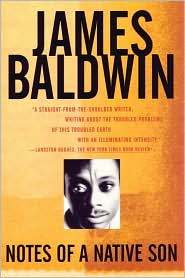Sentence, substance & comma joy
There’s only two kinds of truth.
Let’s get it straight from the start.
It’s all what you believe
in your head and your heart.—Van Morrison, “Little Village”

[James Baldwin: master of style & substance.]
Thankfully teaching impels me to reread and study great literature. I’ve just reread, for a class I’m teaching, “Notes of a Native Son,” America’s greatest essay—greatest because its content deals with our nation’s great topic, race, and because of its artistry—and seen something new in James Baldwin’s famous prose style.Of course his sentences work within a framed structure, opening with his father’s funeral and returning to it to close, and the essay is classically broken into three acts as well. Then there’s Baldwin’s thundering Old Testament condemnation of racism. He shows and explains his own bewildering, maddening experiences with discrimination in the 1950s. And he sees at last how the racism of America’s long apartheid era warped his father. But Baldwin, then 19, has returned too late to his father’s deathbed for them to talk, let alone to discuss how to live with this burden of bitterness.
The essay’s rounded sentences, gravid with clauses and commas, convey a deep and subtle mind groping toward personal and universal truths. Baldwin’s prose itself ruminates. He can be as halting as Henry James. At the same time, conversely, he speeds up his orotund sentences. The combination of lingering and racing ahead creates an interesting rhythm, which is part of the essay’s powerful effect. In both content and style, “Notes of a Native Son” is at once chewy and flowing.
This time through, I saw clearer why that is. Many of the commas that truncate the essay’s sentences are unnecessary, strictly speaking, but lend the essay its thoughtful air. Yet Baldwin usually omits commas at a key juncture. He consistently breaks the rule-of-thumb that commas should assist conjunctions when joining independent clauses. Here’s how I show students this guideline:
The brown dog barked, and the black cat ran.
Without the comma, the “and” seems to set up another action by the dog. Maybe it barked and bit. Without a comma’s cue to slow up, the reader can stumble into that cat. I follow the comma-with-conjunction rule obediently myself, sometimes daring to delete a few commas later. Breaking this convention, however, has a distinguished history. Ernest Hemingway famously linked successive independent clauses only with “and.” Such writers make us to do the work of mentally inserting the commas that traditionally demarcate such clauses, teaching us finally to let go and savor the lilt of sentences without them. Cormac McCarthy loves to omit even more commas, and trains us to his rhythm.

As for Baldwin, he appears to eschew commas with conjunctions in order to impart urgency to otherwise leisurely prose. Note in the example below from “Notes of a Native Son” how, in the first sentence, he omits the called-for comma and then uses a highly optional one, a New Yorker comma, as I think of it. In the second sentence, he declines to set off the introductory clause with a comma but then uses another New Yorker comma. The third sentence restores Baldwin’s thoughtful self-interrupting rhythm. I’ve inserted in brackets where the missing commas might go in the first and second sentences:
When planning a birthday celebration one naturally does not expect that it will be up against competition from a funeral [,] and this girl had anticipated take me out that night, for a big dinner and nightclub afterwards. Sometime during the course of that long day [,] we decided that we would go out anyway, when my father’s funeral service was over. I imagine I decided it, since, as the funeral hour approached, it became clearer and clearer to me that I would not know what to do with myself when it was over.
Here’s another example in which Baldwin eschews the called-for comma-with-conjunction three times in a row. The first sentence in this scene, at his father’s funeral, simply declines the comma. The second declines the comma twice and then employs two commas at the close.
The casket now was opened [,] and the mourners were being led up the aisle to look for the last time on the deceased. The assumption was that the family was too overcome with grief to be allowed to make this journey alone [,] and I watched while my aunt was led to the casket [,] and, muffled in black, and shaking, led back to her seat.
Note how after three rushing independent clauses, Baldwin makes us tap our brakes at the end of the last clause by using two commas. The second of those commas seems, again, very optional, a poet’s usage—most would’ve written “muffled in black and shaking”—but thereby Baldwin makes us see his elderly aunt’s helpless grief for his fractious father. Here again, Baldwin’s doing two things at once, achieving a reasoning manner alongside expressing the raw truth of his heart.
Art, as it will, announces itself first in form in Baldwin’s eloquent memoir essay. But what ultimately makes “Notes of a Native Son” great literature is what it shares with almost all great literature—its illumination of the everlasting and apparently innate human hunger for justice.
The post Sentence, substance & comma joy appeared first on Richard Gilbert.



